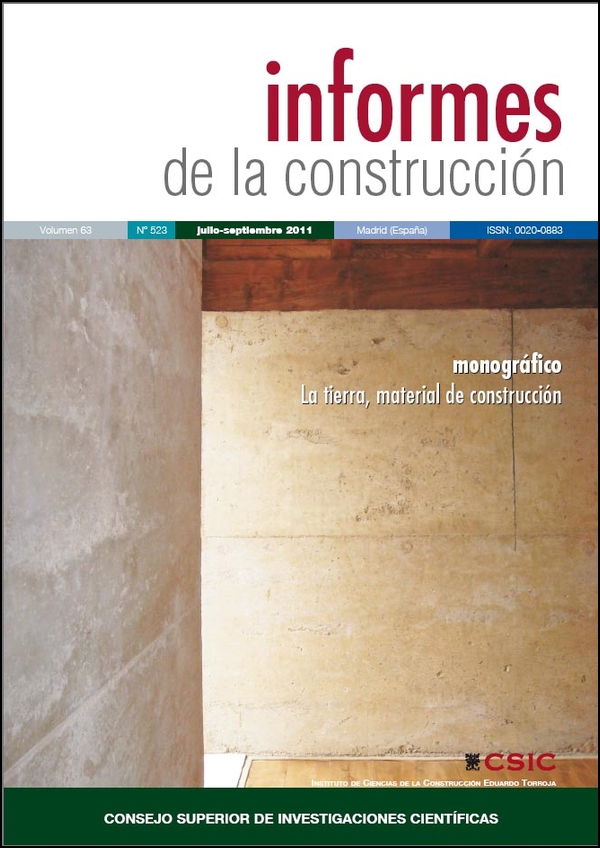Approximation to the earth buildings pathology. Some recommendations of intervention
DOI:
https://doi.org/10.3989/ic.09.007Keywords:
heritage building, construction of earth, earth buildings pathology, sustainable construction, building conservationAbstract
This article shows several points to consider in the study and conservation of the heritage of earth. We show the most characteristic damages of these buildings and we propose some recommendations for the correct diagnostic of their pathology. Finally, some recommendations for the conservation of this heritage are given.
Downloads
References
(1) Monteagudo Rodríguez, I.: Caracterización y evaluación técnica constructiva de mamposterías y tapias de tierra de los siglos XVII, XVIII y XIX. Estudio en la Habana Intramuros. Tesis presentada en opción al grado científico de Doctora en Ciencias Técnicas. Instituto Superior Politécnico “José Antonio Echeverría”, Ciudad de La Habana, 2001.
(2) Dassler, L.; Hinojosa, E. M.; Rainer, L.; Teutonico, J. M.: “CRATerre-EAG, ICCROM – The Project GAIA Research Index. Progress report and future developments”. Comunicaciones Terra ’93. 7ma. Conferencia Internacional sobre el Estudio y la Conservación de la Arquitectura de Tierra. (1993), pp. 597-604. DGEMN, Silves.
(3) Saroza Horta, B.: Estudio del Adobe en las condiciones de Cuba. Tesis presentada en opción al grado científico de Doctora en Ciencias Técnicas. Universidad Central “Marta Abreu” de las Villas, 2004.
(4) Rodríguez, M. A.; Saroza, B.: “Identificación de la composición óptima del adobe como material de construcción de una escuela en Cuba”. Materiales de Construcción. Vol. 56, 282 Abril-junio (2006), pp. 53-62. Consejo Superior de Investigaciones Científi cas, Madrid, España. ISSN: 0465-2746.
(5) ICCRO; CRATerre-EAG; GCI; US/ICOMOS: Adobe ‘90 Preprint, 6ª Conferencia sobre conservación de la arquitectura de Tierra (1990). The Gtty Conservation Institute (GCI), Las Cruces, Nuevo México.
(6) DGEM: “Comunicaciones Terra ‘03”. 7ª Conferencia Internacional sobre el estudio y conservación de la arquitectura de Teirar (1993). DGEMN, Silves.
(7) Odul, P.: “Pathologie humide de constructions en terre: méthodologie de diagnostic”. Adobe ’90 Preprint, 6ta. Conferencia Internacional sobre la Conservación de la Arquitectura de Tierra (1990), pp. 404-416. The Getty Conservation Institute (GCI), Las Cruces,Nuevo México.
(8) Monjo, J.; Maldonado, L.; Rohmer, E.; Vela, F.: “Técnicas de intervención para la recuperación y conservación de los muros de tapial en el patrimonio arquitectónico de la Comunidad Autónoma de Madrid”.Comunicaciones del III Congreso de Rehabilitación del Patrimonio Arquitectónico y Edificación (1996), pp. 344-351. CEDEX - MOPTMA - Universidad de Granada, Granada.
(9)Romeral, J.; Guinea, M.; Rohmer, E.; Salas, J.: “Primeros resultados del trabajo de investigación sobre la tierra como material de construcción en el IETcc.”. Informes de la Construcción (1986). Instituto Eduardo Torrojas, Consejo Superior de Investigaciones Científicas, Madrid.
(10) Chiari, G.: “Caracterización del adobe como material de construcción. Técnicas de preservación”. El adobe. Simposio Internacional y Curso taller sobre conservación del adobe. (1983). pp. 33-44. ICOMOS / UNESCO / ICCROM, Lima.
(11) Houben, H.; Guillaud, H.: Traité de Cobnstruction en Terre. CRATerre-EAG, Grenoble, 1989.
Downloads
Published
How to Cite
Issue
Section
License
Copyright (c) 2011 Consejo Superior de Investigaciones Científicas (CSIC)

This work is licensed under a Creative Commons Attribution 4.0 International License.
© CSIC. Manuscripts published in both the print and online versions of this journal are the property of the Consejo Superior de Investigaciones Científicas, and quoting this source is a requirement for any partial or full reproduction.
All contents of this electronic edition, except where otherwise noted, are distributed under a Creative Commons Attribution 4.0 International (CC BY 4.0) licence. You may read the basic information and the legal text of the licence. The indication of the CC BY 4.0 licence must be expressly stated in this way when necessary.
Self-archiving in repositories, personal webpages or similar, of any version other than the final version of the work produced by the publisher, is not allowed.















